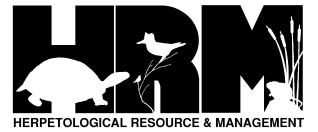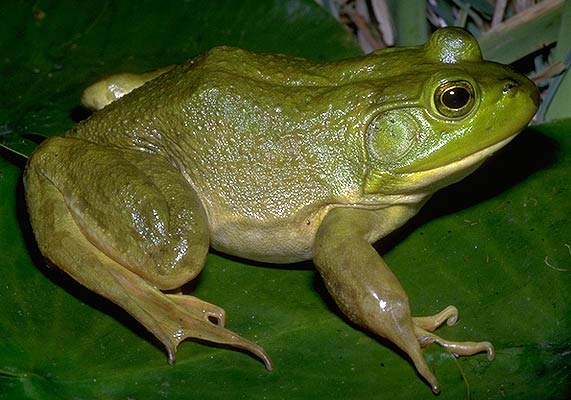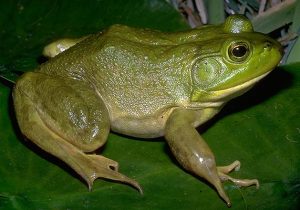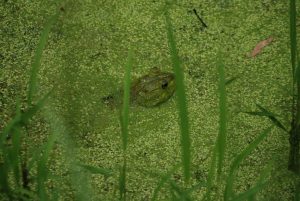Bullfrog
Overview:
Scientific Name: Rana catesbeiana
Size: 3.7 – 8” (adult length), making this the largest frog in North America!
Status: Less common in the north and absent from northern Lake Superior basin. Can be locally common, though has experienced recent declines or even become locally extirpated from areas where previously abundant.
Habitat:
Will inhabit almost any still, permanent body of water, especially in areas with ample submerged and emergent aquatic vegetation. Temporary ponds may be used by dispersing juveniles.
Adult Coloration:
Can be green, yellow green, olive, or brown, sometimes with brown spotting or blotches on back and dark bars on upper legs. Belly white or cream, often with gray mottling.
Adult Characteristics:
No dorsolateral folds (raised ridges running down either side of the back), but a ridge of skin is present from the eye to the shoulder. Toes of hind feet webbed with a free fourth (longest) toe. Skin of young Bullfrogs is smooth, and becomes more bumpy with age. Tympanum (circular “ear” structure) is much larger than the eye in males, and about the same size as the eye in females. Males also have a yellow throat, while females have a white throat. Males are usually more uniform in coloration and smaller than females. Voice: Low-pitched, resonating “brr-rum.” Territorial aggression call is a one- or two-noted squawk or hiccup. e.g., http://www.youtube.com/watch?v=M02_dnl9zCA
Larvae Characteristics:
Tadpoles have a green, olive, or brownish back, sometimes with dark spots that extend to the upper tail fin. Belly is white or yellowish. May reach over 6” during extended larval period that can last upwards of 2 years..
Species Confused With:
Green frog tadpoles are similar, but often have dark spots on both the upper and lower tail fins. Adult Green Frogs also may resemble Bullfrogs, but they have distinct dorsolateral folds extending at least part way down the back, and they have a smaller maximum adult size. The Mink Frog is also smaller, but it may be mistaken for Bullfrogs due to lack of dorsolateral folds. The Mink Frog may be distinguished by the presence of rounded spots or lengthwise blotches on the top of the legs or by the musky odor it releases when handled.
References:
- Amphibians and Reptiles of the Great Lakes Region by Jim Harding
- Harding, J.H. and J.A. Holman. 1992. Michigan Frogs, Toads, and Salamanders. MSU Cooperative Extension Service and MSU Museum. Extension Bull. E-2350, 144 pp.
- Ruthven, A. G., H. B. T. Gaige, et al. 1912. The herpetology of Michigan, by Alexander B. Ruthven. Crystal Thompson and Helen Thompson; Memoranda towards a bibliography of the archaeology of Michigan, by Harlan I. Smith; prepared under the direction of Alexander G. Ruthven. Lansing, Mich., Wynkoop Hallenbeck Crawford, State Printers.
- Holman, J. A. 2012. The Amphibians and Reptiles of Michigan: A Quaternary and Recent Faunal Adventure. Detroit, Mich., Wayne State University Press.
- Conant, R., and Collins, J. T. 1998. Reptiles and Amphibians: Eastern, Central North America. Houghton Mifflin Harcourt Press.



